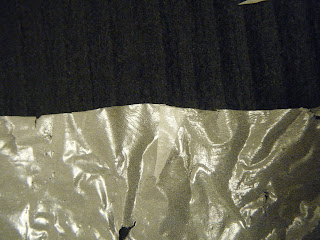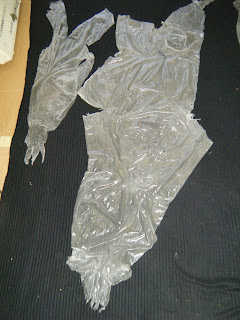My fascinations with the human form and in particular my own body have been realised as two autobiographical expressive animated films. The entire process from starting the course and reaching this conclusion has been full of frustrations, hard work and rewards. I have learnt so much about the techniques and applications of animation and sound design but in particular, I have learnt so much about myself and my practice.
The self negotiated briefs during the course have allowed me to acknowledge my underlying fascinations. At the start of the course, my range of interest in science art and philosophy was something I wanted to present in my animation though it became apparent that this approach was far too wide thematically. I really needed to pinpoint what I wanted to present in my work and I realised it was important to focus my practice. Knowing I wanted to keep to a traditional approach practically, I thought of an idea of combining the traditional technique of drawing on film with something very measured and scientific – drawing and animating brain scans. This then developed into an idea of applying imprints of my skin on glue to the film. An idea expanded and progressed as part of my Masters Project. This skin film idea was the start of discovering where my Masters was going and what my practice is really about. My entire creative career so far seems to have always had some kind of theme centred on representation of the figure and identity. My A level work was based on figurative paintings and photographs of myself and form. My undergraduate degree show was focused on the concept of ‘identity’ and my dissertation was all about artificial intelligence and what makes us human. My inspirations are also mostly figurative artists, Lucian Freud, Edward Muybridge and Jenny Saville for example. This obsession, almost, was reflected again throughout my Masters degree as self expressive animation.
Alongside the expansion of the Skin film idea from the first self negotiated project, I thought of another idea involving using my whole body as a paintbrush to create an animated film of my entire body. These two films were shown as part of my exhibition and assessment for the Masters Project.
Originally, I also intended to show a third film using scans from my own brain. The idea was meant to be a statement about the cognitive aspect of myself and the three films were to be flesh, body and mind – a full autobiography of myself. Fairly early on in my project it became apparent that the brain scans, although the imagery was beautiful and could potentially make for some stunning animation, just did not fit well with the other two films.
One of the reasons for disregarding this idea was due to my original plan to have part of the process of the animations on show at the exhibition (though this was another idea I decided to not progress with as I will discuss). One of the sheets with my body print and a skin body (which was cut up and used for the skin film) could have been used to show and display alongside the films at the exhibition, though there was not any way to of display an object that would work in the tactile way I would want for my brain scan. Also, the imagery produced of the brain scans appeared entirely different to that of the sheet and the skin.
The main reason, however, I decided not to develop the third brain film, was because the other two ideas were very direct and, literal applications of myself. They were much more expressive and self driven, and fitted well together for this reason. There also seemed to have a nice relationship of scale between the two. The brain film did not share this direct and expressive potential. Where the other films were very much my own imagery created using my body, the brain scans were external image creations that would then have had to have been reproduced again to make an original film, separating it contextually from the other two. Nonetheless, I still have my brain scan imagery which could possibly be developed in future in order to possibly make a different type of statement about myself and identity. During my Masters I have found it difficult to really pinpoint my own intentions, and so writing the proposal for my Masters Project was hard for me. Whether this be due to a lack of confidence, stubbornness, a desire to try to force too many themed statements into one or a different reason, this has been the most difficult part of my practice to overcome and I feel as though I have partially resolved this in my Masters Project. Having a year out between starting my Masters Project and completing it also made this a tougher task. After much thought about the statement I wanted to make about the figure for my Masters Project, I decided and realised that I wanted to present the films as autobiographical. The duration of the Masters Project has been a huge learning curve in particular learning about myself, my obsessions and intentions, and this is reflected in my work. I was forced to think very hard about what I really wanted to say about the figure and I realised that I wanted it to be very much a literal projection of myself and my thoughts about myself and my form. Further discoveries were made as I worked on the films and my thoughts and ideas about what I was really saying came to light.
The body film, presents my obsession with body image and I also realised that it shows my frustrations with myself and lack of confidence in my appearance and the pressure presented to women in society to look a certain way. I also considered how if I were male, would I have as much obsession about my own figure and form? I do not believe I would. The images on the sheet are very obviously female and my own, audiences’ reactions and thoughts if the imagery on the sheets were male could be different. I’m aware of the fact that there is a female form on the sheet could suggest a sexual angle to the film, just because of it being a female form. Gender representation in society is seemingly a strong theme in this film. With my films, I really want to communicate my form to allow audiences to be intrigued by its shapes and the way it looks without considering gender, though it would be unavoidable. I would consider the film to be almost a feminist act of rebellion against these attitudes. My body appears and disappears on a sheet repeatedly, like breathe, which brings the film to life. A living breathing form and figure as an animation, a direct, autobiographical representation of myself. Watching it is almost voyeuristic, bringing me back to the possibility of gender importance in the film and my obsession with self representation.
The skin film is a different kind of autobiographical approach. It is genderless and abstract, completely non narrative, a measurement of my own flesh through film. My entire skin, cut up into strips for 35mm film is around two and a half minutes long. The film is visceral, more internal and ironically, more close up and personal, even invasive, than the body film. Although the other film has a feeling of an exposed self, displaying my gender, size and shape, the skin film is actually a much more literal presentation of these aspects. Parts of my hair and skin were pulled off and then attached onto the film as part of the process. Together, the films present what I feel to be a successful autobiographical statement as film.
Towards the end of the project, I still wanted to display one of my sheets with my body print on, and a full body glue skin of myself as part of an installation alongside my films. I originally planned to have the films shown on loop, one after another on one screen, with another section of my space displaying the sheet and glue. With help from tutorials I finally realised that showing these objects would actually detract from the films themselves and draw away from the films on show that are the result of the work. Displaying these objects would be showing the process but after consideration, I would just be repeating my statements or even suggesting other things, i.e. the skin hung up was very eerie and almost horrific. I did not want my show to be about shock value, although I did like the idea of there being something tactile there for the audience to look at and connect with the films. This was a very difficult decision to make as a lot of work went into producing full body glue skin forms of myself and I really wanted to essentially ‘show off’ some of the process to the viewers of the exhibition. I decided to show the two films on separate screens thus producing a much stronger exhibition with a stronger statement about my own self and image and the potential to progress and be presented in different way, i.e. the objects and the brain scans, in possible future exhibitions. From this experience, I feel much more aware of what is expected from an art installation rather than a display of work, and has prepared me for any eventualities in the future for further exhibitions – possibly where I could display the skin and/or sheet as a separate statement, drawing from this work.
My sound design was quite a basic process in my Masters. The sounds produced are literal representations of the objects used during the process. This helps to draw attention to the material and tactile element to the films and works well to connect the films together as well as connecting them to the audience.
To conclude, I feel I have developed and grown as an artist throughout the whole of the Masters course. I would never had expected I would be producing work of such an self expressive nature, but this is clearly where my work belongs, along with exploring themes of the human body, in particular my own. I embarked on the course with an open mind to learn about animation techniques and learn new skills and to revisit old ones. I have come out with so much more, a direction of my practice and the enthusiasm to produce more work of a similar nature in the future along with the confidence in my films and strong ideas behind them and to understand their reasons and justify my decisions.
BODY FILM:
SKIN FILM:
BODY FILM:
SKIN FILM:






























